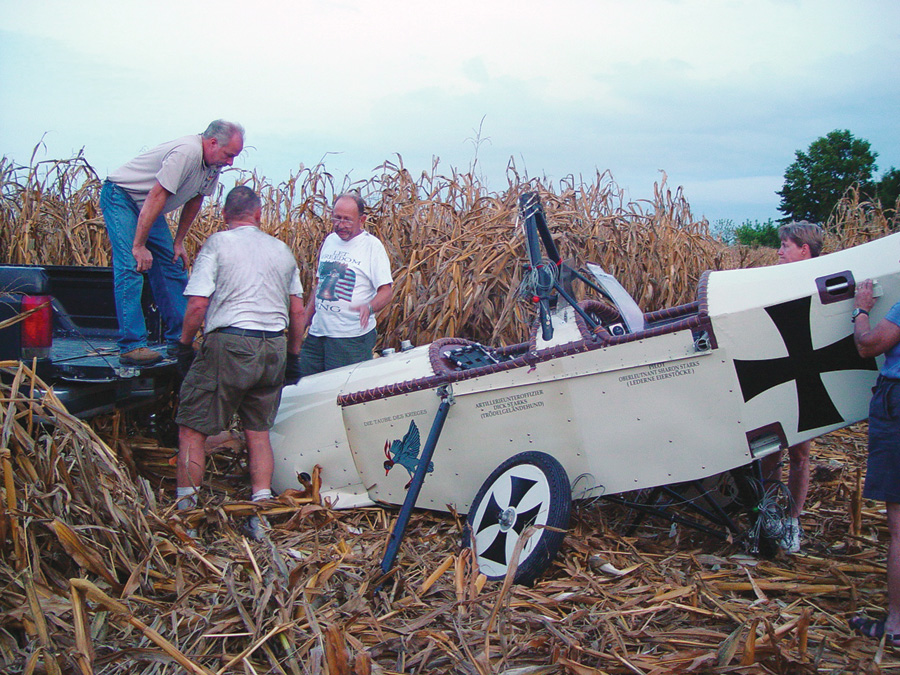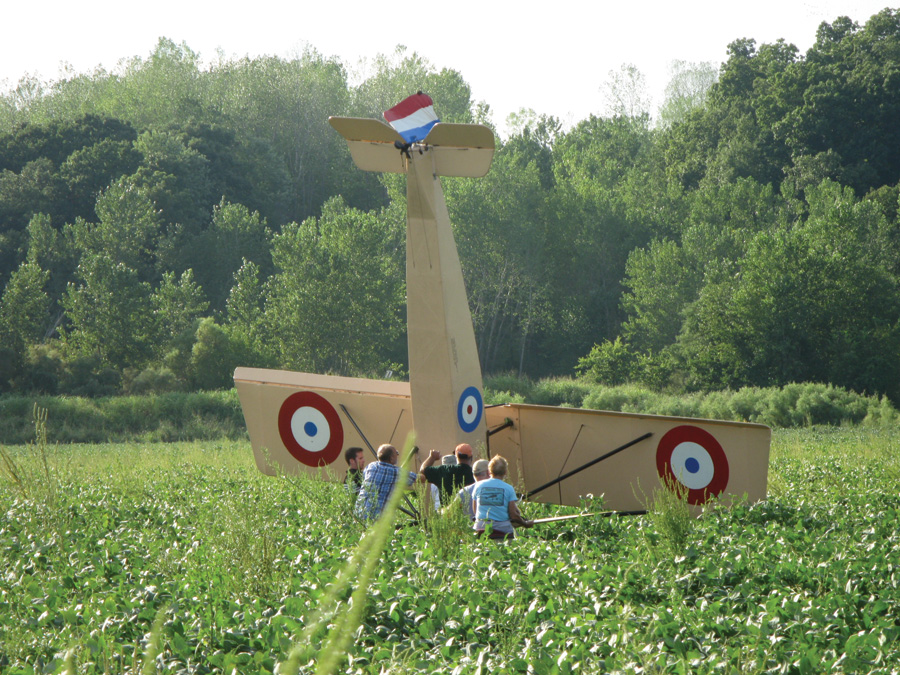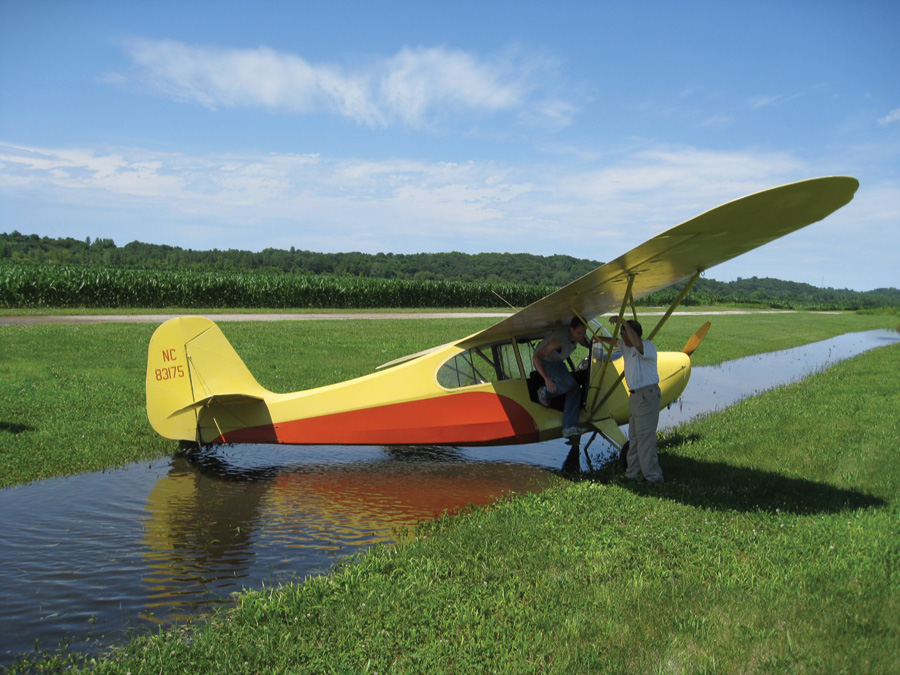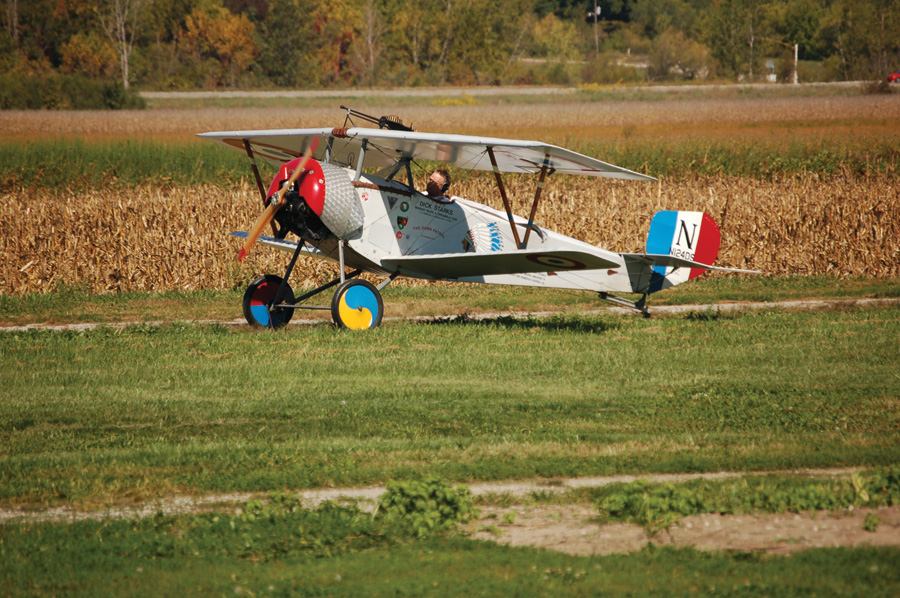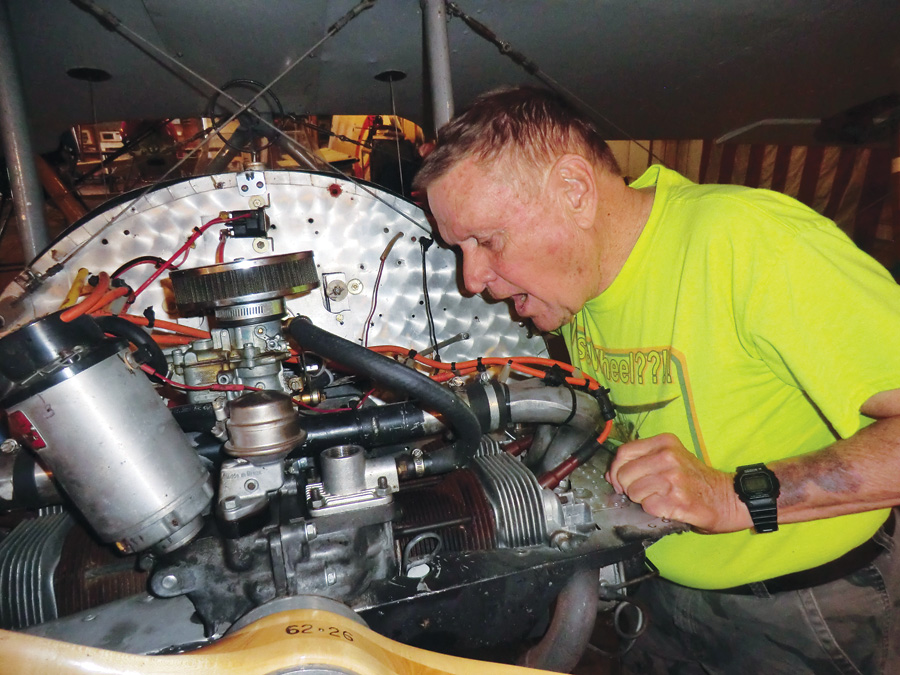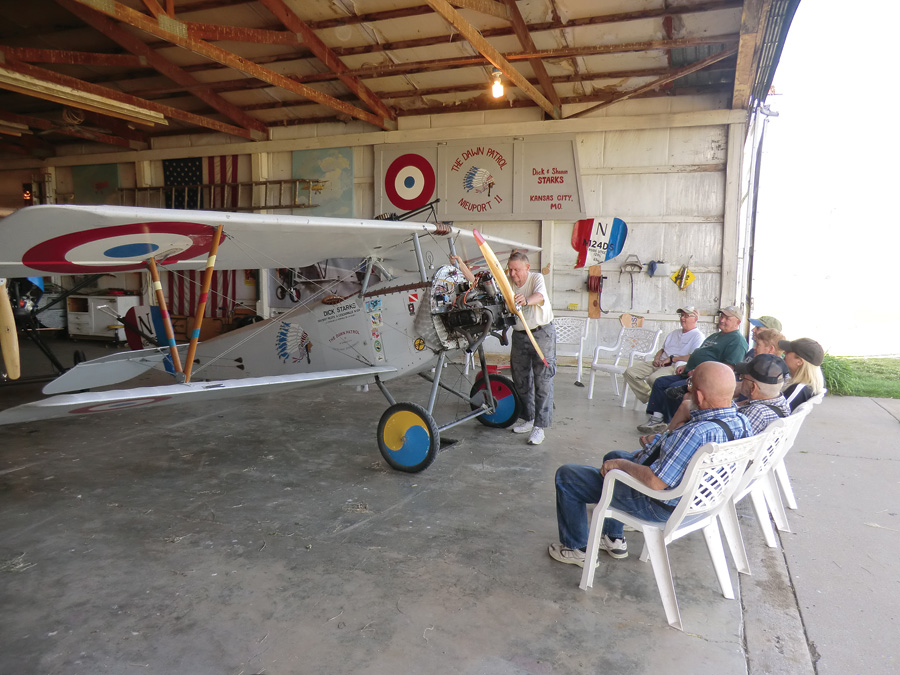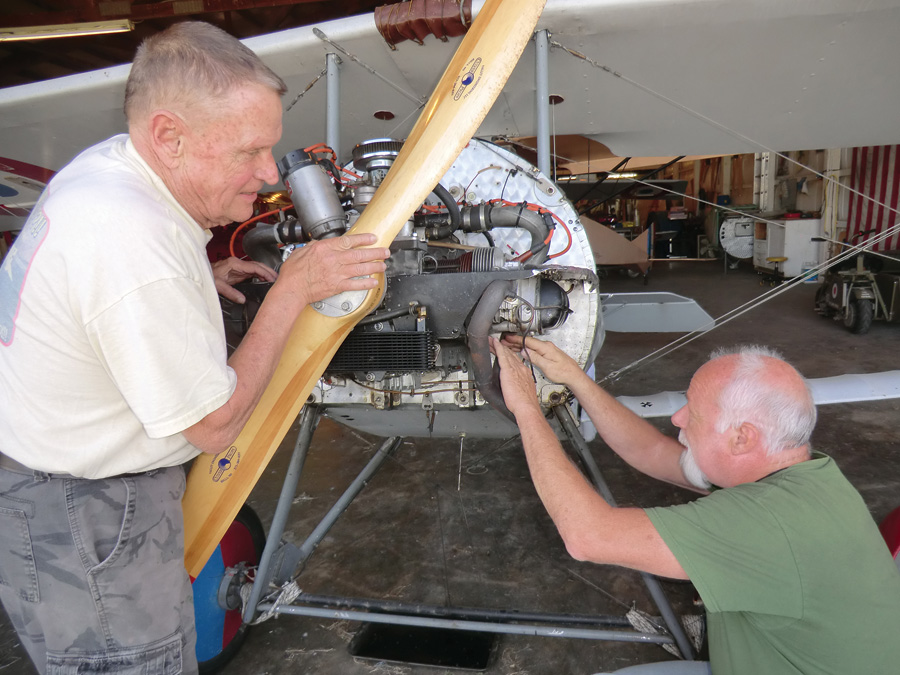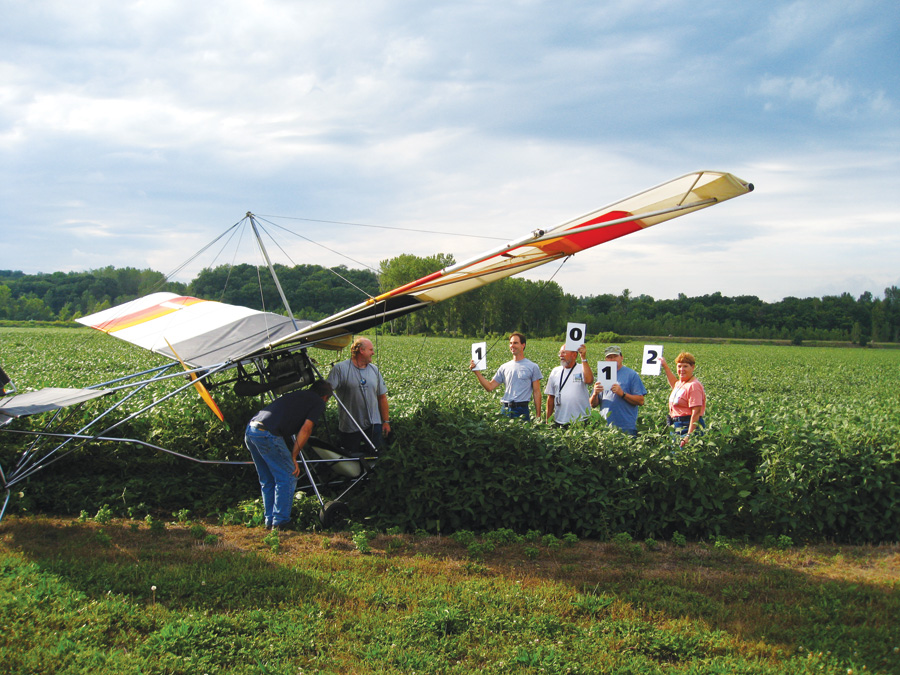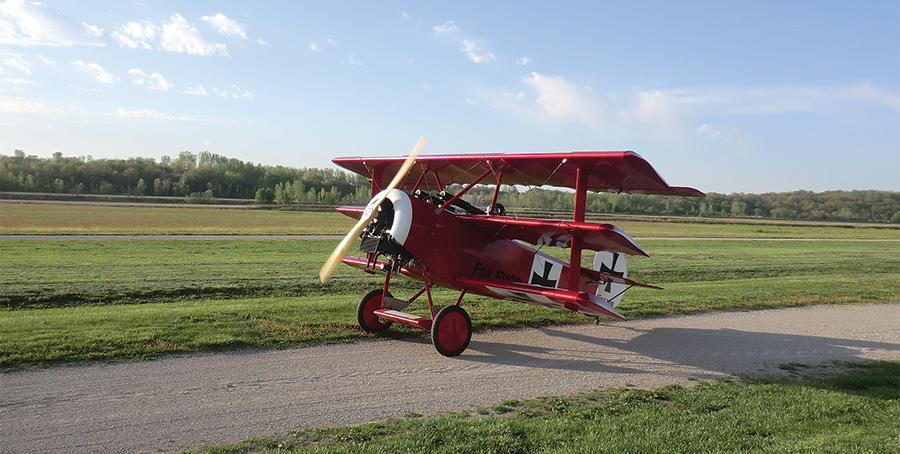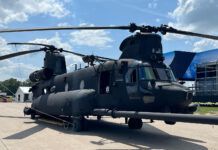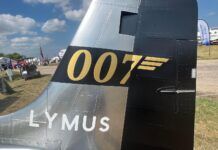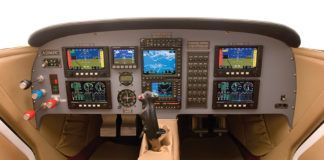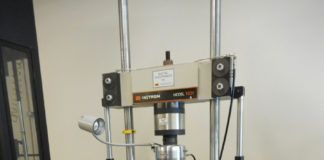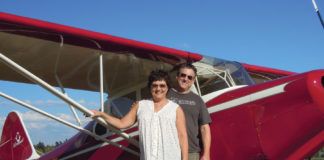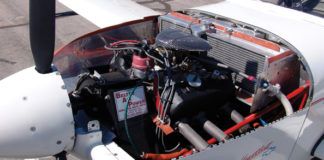This latest little bump in the convoluted road making up my life started off in the simplest way…as do most disasters in my life.
It was a common touch-and-go landing. I’d been out flying in my beloved 28-year-old Graham Lee Nieuport 11, strafing the German trenches just south of Liberty Landing International Airport. After running out of ammo in my 303 Lewis machine gun mounted on the top wing, I decided to head back to the field (at least a two-minute flight) and enjoy some quality time hangar talking with the rest of the airport bums that hang out there. I’m not saying we’re old, but…most of us are retired and banging around the 60 to 80 year old age ranges.
OK…we’re old.
A groundloop or forced landing in a field of eight-foot-tall corn is always going to do some significant damage to the plane (and sometimes the pilot). This is my Taube replica after the engine sagged just after takeoff.
Touch and Go
Anyway, I decided to finish off the flight with some touch and goes down the 1800-foot, gravel, grass, and sand-toad surfaced runway 3/21. I don’t think there’s anything more enjoyable or as challenging as spending time doing touch and goes in a WW-I replica aircraft. Add a crosswind and you’ve got a real educational opportunity.
First, it’s a taildragger aircraft with all the challenges associated with that. Second, most WW-I aircraft had no vertical fin to add some directional stability as you come bounding down the runway. If you make a wheel landing and hold the tail up too long, you risk losing rudder control right at the end of the roll. If that happens and you still have the stick forward keeping the tail off the ground…you suddenly become just a passenger in one of the most exciting rides in the world. Third, 1800 feet of runway is a very long runway for us…but it’s insanely short to pilots used to wide four- and five-thousand-foot runways. Liberty Landing International Airport’s runway is narrow. Maybe 15 feet wide of smooth gravel with about 30 feet of rough turf and sand toads just south of the gravel strip.
Going into a field of soybeans is rarely as damaging as a trip into the corn. Sharon’s damage was fixed in less than a week. (See Kitplanes October 2012.)
To the north of the gravel part is always a grain crop. Soybeans are the most desirable. Corn on the other hand…whooeee! Losing control on landing or takeoff and making a groundloop into a field of eight-foot tall corn is a surefire recipe for a big repair job.
Now, to the south of the turf and sand toads part of the runway is the world famous Liberty Landing International Airport plane-eating ditch.
So, you’re faced with a quandary. Do you want to land on the gravel and risk a nick in your prop and a trip in the beans? Or…do you choose the turf and run the risk of cleaning out the plane-eating ditch? (And your shorts!)
On a gusty 90 crosswind day, it’s a heck of a decision to have to make while on a short quarter-mile final. Personally, I’ll take the ditch over a crop anytime…particularly corn. Been there, done that, don’t ever want to do it again.
But the rewards are great. If you really nail a perfect landing in a gusty crosswind in a WW-I replica you’ll get, in my opinion, the same feeling of accomplishment a USN F-18E/F Super Hornet carrier pilot gets when he catches the third wire landing on a rolling, pitching deck at night…in the fog…short of fuel…with snow and ice on the deck and your backseater busy blowing beets behind you in the cockpit. Landing a short-coupled, twitchy WW-I plane in a gusty 90 crosswind on a narrow strip with obstacles on both sides of the strip is that kinda pressure…at least it is to me!
The plane-eating ditch, especially after a heavy rain, is a surefire plane magnet. Harvey Cleveland and one of his students had the right brake hang up on landing. The sound of that prop splashing the water was actually kinda soothing.
You’re Going Down
When you come across the fence at 45 mph in a WW-I replica and pull the throttle all the way back, you’re going to stop flying right now. About 99% of the time, we have to add power taxiing to make the mid-field turnoff about 900 feet from the threshold. Add a 10- or 15-mph direct crosswind and you’ve got high drama.
Uhhhh…I kinda got off topic there for a while…Back to my touch and go.
I made an acceptable touchdown and once everything was settled down, I shoved the throttle in for the takeoff and go-around. The engine sagged for about two seconds and then picked up and away we went.
Hmm…What could have caused that? I did three more touch and goes and it did the same thing each time.
We can’t have that. I decided to look into this myself with no help from the rest of the herd there in the hangar. I wanted to show them that, for once, I could fix a problem on my engine all by my lonesome. It hadn’t happened yet, but I was hopeful.
There are two schools of thought on how to land a WW-I taildragger. I favor full-stall three-point landings and like to get the tailwheel on the ground as quickly as possible so I have directional control. With this type of landing you’re going as slow as possible when you contact the ground—but you can’t see squat when you’re in the middle of flaring out.
Sharon favors wheel landings because she wants to be able to see where she’s going at all times. The disadvantages are you’ve gotta carry more speed on the round-out and, at some time, as your speed drops, the tail has to come down. When that happens, there’s a period of time when your rudder may—or may not—provide any authority to keep directional control.
Back at the Hangar
I taxied back, shut down, and pulled the plane into the hangar. Taking off the cowl, I looked first at the throttle linkage to see if the little thingy that operates the accelerator jet was attached. It looked OK.
So, the next thing on the list was to remove the carburetor and just check it out. I wanted to see if there was some crud in the float chamber, clogged jets, or maybe some inner springy thingy in the accelerator pump had gone bad. I rolled my tool chest over to the plane and opened it up. That’s when the slow-motion ballet started.
First I heard someone mutter, “Uh-oh…Starks is getting out his tools.” Plastic chairs could be heard being moved around in the hangar. Someone else opened the first-aid cabinet.
All this was going on while I was loosening the throttle cable, unhooking the gas line, and cutting lots of zip ties that were used to hold everything in place in the engine compartment.
It got real quiet, so I turned around and there they were. The audience was arranged around me in a semicircle of interested eyes. This was usual when anyone was working on his or her plane. There is always an audience.
I ignored them. It was while I was taking the bug nut off the throttle arm with a little Allen wrench that disaster struck.
The wrench popped out of the Allen screw and fell down into the engine. Tinkle…tinkle…ping. That was it. There was no sound of the Allen wrench hitting the floor. In my hurry, I’d forgotten to put a towel over the engine to catch things like that, and now I was paying the price.
This is a reenactment of the disaster with me looking like I’m sure I looked when that Allen wrench went down between the cylinders to the top of the cooling tin.
Looking down between the cylinders, I could barely make out the end of the Allen wrench where it was resting on top of the cooling tin. The cooling tin is a metal insert that sits under the cylinders between the pushrod tubes. It’s used to direct air through the cooling fins on the cylinders.
My blood ran cold. This was a very bad thing!
To get to the cooling tin and hence to the Allen wrench, I’d have to do a lot of tedious, time consuming stuff: First, take off the baffling around the engine. Second, take off the rocker arm cover. Third, take off the rocker arms. Fourth, take out the pushrods. Fifth take out the pushrod tubes.
Then I’d finally be able to take out the cooling tin and get to the #?&*@%!! Allen wrench.
After that, I’d get to reverse the whole procedure. After everything was all back together, then I’d have to go through the ordeal of readjusting the rocker arm clearances. I was looking at more than a full day’s work.
All in all, my day had suddenly turned dark brown with the “tinkle…tinkle…ping” and all that it entailed.
Stunned at this shocking turn of events, I staggered back from the engine and sat down in one of the available chairs.
The audience quit chattering when they noticed me sitting there with a shocked look on my pale face.
Tom Glaeser finally broke the silence. “What’d you do dummy?” (“Dummy” is one of the more printable names I’m called at the field.)
“I dropped the Allen wrench in the engine.”
“I’m guessing you didn’t have a rag over the engine.”
“Nope.”
There was a long silence.
Jerry (The Rotaxman) Sharp broke the silence. “Can you see the Allen wrench?” he asked.
“Sorta,” I replied.
“Lemme in there,” Jerry said. “I bet I can get it out.”
Jay Williams gets his score after he “lost it” on landing and drove Dick Lemons’ Quicksilver MX into the beans.
Rotaxman to the Rescue
Now, I’ve gotta tell you, Jerry Sharp is one heck of a mechanic on anything that moves. He’s really talented on Rotax engines, which is where his nickname, the Rotaxman, comes from. He’s flown with them for over 25 years. Now, even though he’s moved up to an Avid Magnum with a big ol’ snarly 150-hp Lycoming in front, he’s still the number-one man people in the Kansas City area go to with Rotax engine issues…or for that matter, anything else engine related. If Jerry can’t fix it, you might as well throw it in the river (which he’s done too, by the way).
With me holding a flashlight and telling him what the wires were doing, Jerry did some magic with several bent pieces of safety wire and got that Allen wrench out of the cooling tin in about 15 minutes. I did learn some new words while he was working, too. Guys like the Rotaxman are good to have around!
With that problem solved and a rag placed over the engine, the carburetor was removed and taken to a workbench. Now I did have a circle of heads grouped over the carb as we opened it up. A carburetor is a fascinating piece of equipment. They are also totally confusing. As far as I’m concerned, they use black magic to work.
Dick Lemons has to make wheel landings in his Airdrome Airplanes Fokker DR-1 triplane. It is the worst plane at the field in terms of visibility in the three-point configuration. But on the plus side of the column, it’s the easiest to control in the tail-high configuration.
It was squeaky clean inside. No clogged jets. The accelerator pump was working fine. The final consensus was that there was no reason for the engine to be doing that.
That was not particularly what I wanted to hear, but it was also good to know that there was nothing wrong with the carburetor.
The carburetor was reassembled with new gaskets. Then it was put back on the now rag-covered engine. Everything was hooked back up, and we gave it a “smoke test” to see if the engine still ran.
With everything checked out, I took her back up for a touch and go.
She still sagged when I pushed the throttle back in, but came back strong after one or two seconds.
That was two months ago and nothing’s changed. She still sags, but only on touch and goes. Heads are being scratched and online engine blogs read and discussed.
What’s a pilot to do?
This Adventure ain’t over yet.

